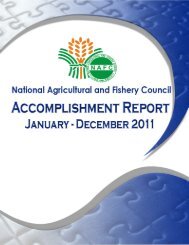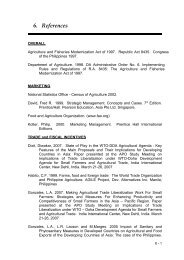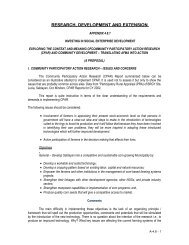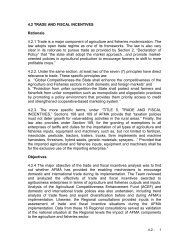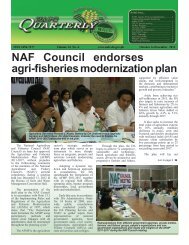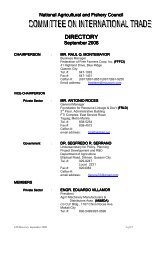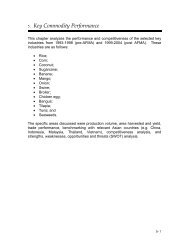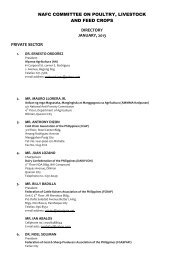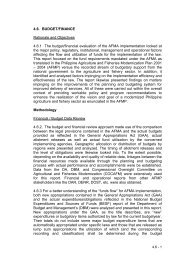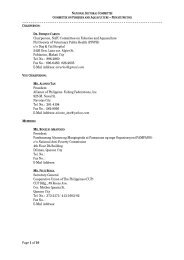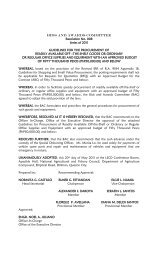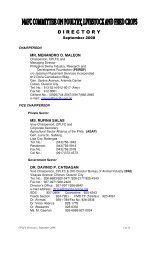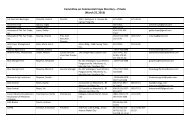EXECUTIVE SUMMARY - National Agricultural and Fishery Council ...
EXECUTIVE SUMMARY - National Agricultural and Fishery Council ...
EXECUTIVE SUMMARY - National Agricultural and Fishery Council ...
You also want an ePaper? Increase the reach of your titles
YUMPU automatically turns print PDFs into web optimized ePapers that Google loves.
14. AFMA Period. From 1999-2004, the sector registered a relatively<br />
impressive growth of 4.1 percent per year. The strong performers were<br />
several crops, poultry <strong>and</strong> fishery.<br />
15. In terms of contributions to growth, some 57 percent of the growth<br />
between 1993 <strong>and</strong> 1997 came from crops, 24.6 percent from poultry, 23.5<br />
percent from livestock <strong>and</strong> 7.9 percent from fishery. Forestry <strong>and</strong><br />
agricultural activities <strong>and</strong> services had negative contributions. Meanwhile,<br />
between 1999 <strong>and</strong> 2004, the growth contribution of crops dropped to 42<br />
percent. The same was true for poultry <strong>and</strong> livestock. <strong>Fishery</strong>,<br />
meanwhile, managed to increase its share to 33.7 percent.<br />
16. The numbers showed that during the pre-AFMA period, market-driven,<br />
private sector-led commodities contributed over half of growth, primarily<br />
other crops, livestock <strong>and</strong> poultry. Palay also provided solid contribution.<br />
By contrast, during the AFMA period, the market driven, private sector-led<br />
commodities (livestock, poultry <strong>and</strong> more so fishery - mainly seaweeds)<br />
provided the buoyancy.<br />
17. Relative to selected country competitors, the Philippines’ agriculture<br />
performance was not far behind compared to the 1980s. In 1993-1997, it<br />
fared better than Malaysia <strong>and</strong> Indonesia. While it posted the worst El<br />
Niño contraction in 1998, it managed to bounce back in the succeeding<br />
years, still surpassing the two countries. Thail<strong>and</strong> <strong>and</strong> Vietnam, though,<br />
were far better performers all throughout.<br />
18. The nagging question is the high incidence of the poor in the rural sector<br />
where agriculture is the primary occupation. Poverty is an agriculture<br />
phenomenon (Senator Edgardo J. Angara, c. 2000). This makes<br />
agriculture both a threat to growth <strong>and</strong> an opportunity.<br />
Overall Productivity<br />
19. The growth of agriculture labor productivity in the country, as represented<br />
by the agriculture real value added per worker, improved from 0.7 percent<br />
per year in 1993-1998 to 1.3 percent per year in 1999-2002. Growth,<br />
however, lagged behind other Asian countries. In 1999-2002, Philippine<br />
growth was only a third of Thail<strong>and</strong>, a fourth of Vietnam, <strong>and</strong> a little over a<br />
fifth of Malaysia.<br />
20. Meanwhile, in terms of l<strong>and</strong> productivity, as measured by agriculture real<br />
value added per hectare, growth averaged 2.2 percent in 1993-1998,<br />
accelerating to 7.4 percent per year in 1999-2002. Performance was<br />
significantly better compared to its Asian counterparts. This could imply<br />
that agriculture growth in the Philippines could be driven more by yield<br />
improvements (e.g. through the use of better varieties) rather than area<br />
expansions, especially in 1999-2002. However, its l<strong>and</strong> per worker was<br />
declining faster than its Asian neighbors.<br />
xxvi



